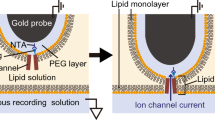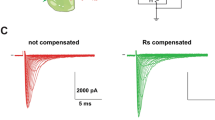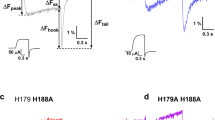Abstract
Voltage-gated ion channels regulate many physiological functions and are targets for a number of drugs. Patch-clamp electrophysiology is the standard method for measuring channel activity because it fulfils the requirements for voltage control, repetitive stimulation and high temporal resolution, but it is laborious and costly. Here we report an electro-optical technology and automated instrument, called the electrical stimulation voltage ion probe reader (E-VIPR), that measures the activity of voltage-gated ion channels using extracellular electrical field stimulation and voltage-sensitive fluorescent probes. We demonstrate that E-VIPR can sensitively detect drug potency and mechanism of block on the neuronal human type III voltage-gated sodium channel expressed in human embryonic kidney cells. Results are compared with voltage-clamp and show that E-VIPR provides sensitive and information-rich compound blocking activity. Furthermore, we screened ∼400 drugs and observed sodium channel–blocking activity for ∼25% of them, including the antidepressants sertraline (Zoloft) and paroxetine (Paxil).
This is a preview of subscription content, access via your institution
Access options
Subscribe to this journal
Receive 12 print issues and online access
$209.00 per year
only $17.42 per issue
Buy this article
- Purchase on Springer Link
- Instant access to full article PDF
Prices may be subject to local taxes which are calculated during checkout





Similar content being viewed by others
References
Brau, M.E., Dreimann, M., Olschewski, A., Vogel, W. & Hempelmann, G. Effect of drugs used for neuropathic pain management on tetrodotoxin-resistant Na(+) currents in rat sensory neurons. Anesthesiology 94, 137–144 (2001).
Carmeliet, E. & Mubagwa, K. Antiarrhythmic drugs and cardiac ion channels: mechanisms of action. Prog. Biophys. Mol. Biol. 70, 1–72 (1998).
White, H.S. Comparative anticonvulsant and mechanistic profile of the established and newer antiepileptic drugs. Epilepsia 40 suppl. Suppl 5, S2–10 (1999).
Courtney, K.R. Mechanism of frequency-dependent inhibition of sodium currents in frog myelinated nerve by the lidocaine derivative GEA. J. Pharmacol. Exp. Ther. 195, 225–236 (1975).
Scholz, A. Mechanisms of (local) anaesthetics on voltage-gated sodium and other ion channels. Br. J. Anaesth. 89, 52–61 (2002).
Clare, J.J., Tate, S.N., Nobbs, M. & Romanos, M.A. Voltage-gated sodium channels as therapeutic targets. Drug Discov. Today 5, 506–520 (2000).
Schroeder, K., Neagle, B., Trezise, D.J. & Worley, J. Ionworks HT: a new high-throughput electrophysiology measurement platform. J. Biomol. Screen. 8, 50–64 (2003).
Wood, C., Williams, C. & Waldron, G.J. Patch clamping by numbers. Drug Discov. Today 9, 434–441 (2004).
Bennett, P.B. & Guthrie, H.R. Trends in ion channel drug discovery: advances in screening technologies. Trends Biotechnol. 21, 563–569 (2003).
Worley, J.F., III & Main, M.J. An industrial perspective on utilizing functional ion channel assays for high throughput screening. Receptors Channels 8, 269–282 (2002).
Zheng, W., Spencer, R.H. & Kiss, L. High throughput assay technologies for ion channel drug discovery. Assay Drug Dev. Technol. 2, 543–552 (2004).
Felix, J.P. et al. Functional assay of voltage-gated sodium channels using membrane potential-sensitive dyes. Assay Drug Dev. Technol. 2, 260–268 (2004).
Maher, M.P. & Gonzalez, J.E. Multi-well plate and electrode assemblies for ion channel assays. US patent 6,969,449 B2 (2005).
Maher, M.P. & Gonzalez, J.E. High throughput method and system for screening candidate compounds for activity against ion channels. US patent 6,686,193 B2 (2004).
Kim, C.H., Oh, Y., Chung, J.M. & Chung, K. The changes in expression of three subtypes of TTX sensitive sodium channels in sensory neurons after spinal nerve ligation. Brain Res. Mol. Brain Res. 95, 153–161 (2001).
Black, J.A., Liu, S., Tanaka, M., Cummins, T.R. & Waxman, S.G. Changes in the expression of tetrodotoxin-sensitive sodium channels within dorsal root ganglia neurons in inflammatory pain. Pain 108, 237–247 (2004).
Gonzalez, J.E. & Tsien, R.Y. Voltage sensing by fluorescence resonance energy transfer in single cells. Biophys. J. 69, 1272–1280 (1995).
Gonzalez, J.E. & Tsien, R.Y. Improved indicators of cell membrane potential that use fluorescence resonance energy transfer. Chem. Biol. 4, 269–277 (1997).
Gonzalez, J.E., Oades, K., Leychkis, Y., Harootunian, A. & Negulescu, P.A. Cell-based assays and instrumentation for screening ion-channel targets. Drug Discov. Today 4, 431–439 (1999).
Mao, J. & Chen, L.L. Systemic lidocaine for neuropathic pain relief. Pain 87, 7–17 (2000).
Lenkowski, P.W., Shah, B.S., Dinn, A.E., Lee, K. & Patel, M.K. Lidocaine block of neonatal Nav1.3 is differentially modulated by co-expression of beta1 and beta3 subunits. Eur. J. Pharmacol. 467, 23–30 (2003).
Postma, S.W. & Catterall, W.A. Inhibition of binding of [3H]batrachotoxinin A 20-alpha-benzoate to sodium channels by local anesthetics. Mol. Pharmacol. 25, 219–227 (1984).
Conti, F., Gheri, A., Pusch, M. & Moran, O. Use dependence of tetrodotoxin block of sodium channels: a revival of the trapped-ion mechanism. Biophys. J. 71, 1295–1312 (1996).
Eickhorn, R., Weirich, J., Hornung, D. & Antoni, H. Use dependence of sodium current inhibition by tetrodotoxin in rat cardiac muscle: influence of channel state. Pflugers Arch. 416, 398–405 (1990).
John, V.H. et al. Heterologous expression and functional analysis of rat Na(V)1.8 (SNS) voltage-gated sodium channels in the dorsal root ganglion neuroblastoma cell line ND7–23. Neuropharmacology 46, 425–438 (2004).
Song, J.H., Huang, C.S., Nagata, K., Yeh, J.Z. & Narahashi, T. Differential action of riluzole on tetrodotoxin-sensitive and tetrodotoxin-resistant sodium channels. J. Pharmacol. Exp. Ther. 282, 707–714 (1997).
Wang, G.K., Russell, C. & Wang, S.Y. State-dependent block of voltage-gated Na+ channels by amitriptyline via the local anesthetic receptor and its implication for neuropathic pain. Pain 110, 166–174 (2004).
Nau, C., Seaver, M., Wang, S.Y. & Wang, G.K. Block of human heart hH1 sodium channels by amitriptyline. J. Pharmacol. Exp. Ther. 292, 1015–1023 (2000).
Bielefeldt, K., Ozaki, N., Whiteis, C. & Gebhart, G.F. Amitriptyline inhibits voltage-sensitive sodium currents in rat gastric sensory neurons. Dig. Dis. Sci. 47, 959–966 (2002).
Ragsdale, D.S., McPhee, J.C., Scheuer, T. & Catterall, W.A. Molecular determinants of state-dependent block of Na+ channels by local anesthetics. Science 265, 1724–1728 (1994).
Akiba, I. et al. Stable expression and characterization of human PN1 and PN3 sodium channels. Receptors Channels 9, 291–299 (2003).
Kuo, C.C. & Lu, L. Characterization of lamotrigine inhibition of Na+ channels in rat hippocampal neurones. Br. J. Pharmacol. 121, 1231–1238 (1997).
Lang, D.G., Wang, C.M. & Cooper, B.R. Lamotrigine, phenytoin and carbamazepine interactions on the sodium current present in N4TG1 mouse neuroblastoma cells. J. Pharmacol. Exp. Ther. 266, 829–835 (1993).
Xie, X., Lancaster, B., Peakman, T. & Garthwaite, J. Interaction of the antiepileptic drug lamotrigine with recombinant rat brain type IIA Na+ channels and with native Na+ channels in rat hippocampal neurones. Pflugers Arch. 430, 437–446 (1995).
Hebert, T., Drapeau, P., Pradier, L. & Dunn, R.J. Block of the rat brain IIA sodium channel alpha subunit by the neuroprotective drug riluzole. Mol. Pharmacol. 45, 1055–1060 (1994).
Zhang, J.H., Chung, T.D. & Oldenburg, K.R. A Simple statistical parameter for use in evaluation and validation of high throughput screening assays. J. Biomol. Screen. 4, 67–73 (1999).
Pera, M. The Ambiguous Frog: The Galvani-Volta Controversy on Animal Electricity (Princeton University Press, Princeton, N.J., 1992).
Basser, P.J. & Roth, B.J. New currents in electrical stimulation of excitable tissues. Annu. Rev. Biomed. Eng. 2, 377–397 (2000).
Roth, B.J. Mechanisms for electrical stimulation of excitable tissue. Crit. Rev. Biomed. Eng. 22, 253–305 (1994).
Benabid, A.L. et al. Therapeutic electrical stimulation of the central nervous system. C. R. Biol. 328, 177–186 (2005).
Burnett, P. et al. Fluorescence imaging of electrically stimulated cells. J. Biomol. Screen. 8, 660–667 (2003).
Baxter, D.F. et al. A novel membrane potential-sensitive fluorescent dye improves cell-based assays for ion channels. J. Biomol. Screen. 7, 79–85 (2002).
Leffler, A., Herzog, R.I., Dib-Hajj, S.D., Waxman, S.G. & Cummins, T.R. Pharmacological properties of neuronal TTX-resistant sodium channels and the role of a critical serine pore residue. Pflugers Arch. 451, 454–463 (2005).
Tomiko, S.A., Rosenberg, R.L., Emerick, M.C. & Agnew, W.S. Fluorescence assay for neurotoxin-modulated ion transport by the reconstituted voltage-activated sodium channel isolated from eel electric organ. Biochemistry 25, 2162–2174 (1986).
Vickery, R.G. et al. Comparison of the pharmacological properties of rat Na(V)1.8 with rat Na(V)1.2a and human Na(V)1.5 voltage-gated sodium channel subtypes using a membrane potential sensitive dye and FLIPR. Receptors Channels 10, 11–23 (2004).
Yang, Y.C. & Kuo, C.C. Inhibition of Na(+) current by imipramine and related compounds: different binding kinetics as an inactivation stabilizer and as an open channel blocker. Mol. Pharmacol. 62, 1228–1237 (2002).
Abdi, S., Lee, D.H. & Chung, J.M. The anti-allodynic effects of amitriptyline, gabapentin, and lidocaine in a rat model of neuropathic pain. Anesth. Analg. 87, 1360–1366 (1998).
Carter, G.T. & Sullivan, M.D. Antidepressants in pain management. Curr. Opin. Investig. Drugs 3, 454–458 (2002).
Maizels, M. & McCarberg, B. Antidepressants and antiepileptic drugs for chronic non-cancer pain. Am. Fam. Physician 71, 483–490 (2005).
Schulz, M. & Schmoldt, A. Therapeutic and toxic blood concentrations of more than 800 drugs and other xenobiotics. Pharmazie 58, 447–474 (2003).
Doran, A. et al. The impact of P-glycoprotein on the disposition of drugs targeted for indications of the central nervous system: evaluation using the MDR1A/1B knockout mouse model. Drug Metab. Dispos. 33, 165–174 (2005).
Chen, Y.H. et al. Cloning, distribution and functional analysis of the type III sodium channel from human brain. Eur. J. Neurosci. 12, 4281–4289 (2000).
Acknowledgements
We thank Charlie Cohen, Jennings Worley, Jeff Stack and Kevin Beaumont for review of manuscript and providing useful suggestions.
Author information
Authors and Affiliations
Corresponding author
Ethics declarations
Competing interests
The authors declare no competing financial interests.
Rights and permissions
About this article
Cite this article
Huang, CJ., Harootunian, A., Maher, M. et al. Characterization of voltage-gated sodium-channel blockers by electrical stimulation and fluorescence detection of membrane potential. Nat Biotechnol 24, 439–446 (2006). https://doi.org/10.1038/nbt1194
Received:
Accepted:
Published:
Issue Date:
DOI: https://doi.org/10.1038/nbt1194
This article is cited by
-
Bioelectricity in dental medicine: a narrative review
BioMedical Engineering OnLine (2024)
-
Electrostimulus-triggered reactive oxygen species level in organelles revealed by organelle-targeting SERS nanoprobes
Analytical and Bioanalytical Chemistry (2022)
-
Human neuronal signaling and communication assays to assess functional neurotoxicity
Archives of Toxicology (2021)
-
Dynamic all-optical drug screening on cardiac voltage-gated ion channels
Scientific Reports (2018)
-
Differential Inhibition of Nav1.7 and Neuropathic Pain by Hybridoma-Produced and Recombinant Monoclonal Antibodies that Target Nav1.7
Neuroscience Bulletin (2018)



